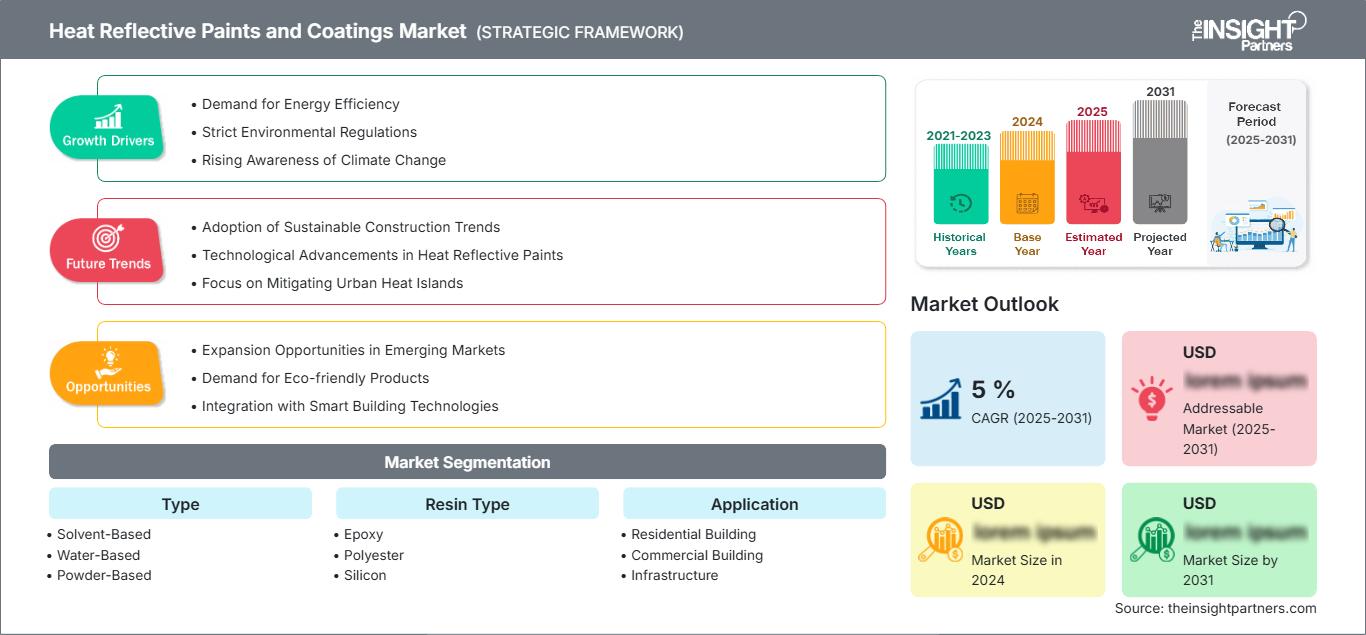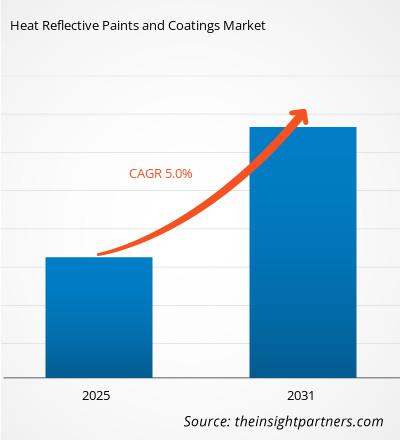The Heat Reflective Paints and Coating Market is expected to register a CAGR of 5 % from 2025 to 2031, with a market size expanding from US$ XX million in 2024 to US$ XX Million by 2031.
The report is segmented by type (solvent-based, water-based, powder-based), resin type (epoxy, polyester, silicon, acrylic, others). The report further presents analysis based on application (residential building, commercial building, infrastructure, automotive, industrial, others). Global analysis is further broken-down at regional level and major countries. In terms of geography, the market is divided into North America, Europe, Asia Pacific, Middle East and Africa, and South and Central America). The Report Offers the Value in USD for the above analysis and segments.
Purpose of the Report
The report Heat Reflective Paints and Coating Market by The Insight Partners aims to describe the present landscape and future growth, top driving factors, challenges, and opportunities. This will provide insights to various business stakeholders, such as:
- Technology Providers/Manufacturers: To understand the evolving market dynamics and know the potential growth opportunities, enabling them to make informed strategic decisions.
- Investors: To conduct a comprehensive trend analysis regarding the market growth rate, market financial projections, and opportunities that exist across the value chain.
- Regulatory bodies: To regulate policies and police activities in the market with the aim of minimizing abuse, preserving investor trust and confidence, and upholding the integrity and stability of the market.
Heat Reflective Paints and Coating Market Segmentation
Type
- Solvent-Based
- Water-Based
- Powder-Based
Resin Type
- Epoxy
- Polyester
- Silicon
- Acrylic
Application
- Residential Building
- Commercial Building
- Infrastructure
- Automotive
- Industrial
Geography
- North America
- Europe
- Asia-Pacific
- South and Central America
- Middle East and Africa
You will get customization on any report - free of charge - including parts of this report, or country-level analysis, Excel Data pack, as well as avail great offers and discounts for start-ups & universities
Heat Reflective Paints and Coatings Market: Strategic Insights

-
Get Top Key Market Trends of this report.This FREE sample will include data analysis, ranging from market trends to estimates and forecasts.
Heat Reflective Paints and Coating Market Growth Drivers
- Demand for Energy Efficiency: One of the most significant reasons for heat reflective paints and coatings is based on demand for efficiency in energy. One of the most important goals of businesses and houses is cutting down on consumption of energy and lowering the cost of cooling, which is why businesses and households seek roofs and other exterior surfaces coatings that absorb minimal heat.
- Strict Environmental Regulations: Another key enabler is strict environmental regulations pertaining to the mitigation of urban heat islands and focus on sustainable construction practices. To this end, different governments are promoting heat reflective paints in a bid to expand green buildings, thereby furthering growth within the market and adoption within construction and renovation projects.
- Rising Awareness of Climate Change: Awareness regarding climate change and its impact forms the greatest reason for an increase in market demand for heat reflective paints and coatings. As consumers and industries become increasingly concerned with environmental footprint, greater preference is found towards products that contribute towards cooler urban environments and lower greenhouse gas emissions, thereby improving market potential.
Heat Reflective Paints and Coating Market Future Trends
- Adoption of Sustainable Construction Trends: A critical trend in the market for heat reflective paints and coatings is increasing the adoption of sustainable construction trends. As building and architects seek greener materials, they are incorporating more heat reflective coatings into new project development to enhance energy efficiency and cut down on environmental footprint within the context of green building certifications.
- Technological Advancements in Heat Reflective Paints: The emergent trend in heat reflective paints technology is new formulation. There have indeed been tremendous strides regarding technological advancement in heat reflective paints. Keeping manufacturers abreast of the curve has been developing smarter and more efficient products with superior heat reflection and longer life. Such innovations serve to enhance performance as well as extend application opportunities on diverse surfaces across various climates.
- Focus on Mitigating Urban Heat Islands: Increasingly, it has been focused on the mitigation of the urban heat island with increased demand for heat reflective paints. The cities are found to be implementing policies to combat increased temperatures thus spreading the use of reflective coatings on pavements and roofs. Therefore it supports public health initiatives and promotes livability in cities.
Heat Reflective Paints and Coating Market Opportunities
- Expansion Opportunities in Emerging Markets: Going by the trends emerging in the market for reflective heat paints and coatings, it can be seen that the emerging markets can prove to be a good expansion opportunity. Developing countries are showing more interest in energy efficiency and sustainable construction. This means lots of scope for firms to capture new customers and open up new revenue streams.
- Demand for Eco-friendly Products: There exists a big opportunity for the development of eco-friendly heat reflective products. For instance, low-VOC and more ecofriendly formulations are being opted by companies and consumers, meaning innovative manufacturers will be able to capture the market in terms of mainstream appeal and meet regulatory requirements.
- Integration with Smart Building Technologies: Integration of heat reflective paints with smart building technologies is very interesting. This would make reflective coatings that complement energy management systems integrate well with the overall energy efficiency of a building. Therefore, such a solution will be in line with the needs of tech-savvy consumers and those commercial clients keen on more advanced solutions.
Heat Reflective Paints and Coatings Market Regional Insights
The regional trends and factors influencing the Heat Reflective Paints and Coatings Market throughout the forecast period have been thoroughly explained by the analysts at The Insight Partners. This section also discusses Heat Reflective Paints and Coatings Market segments and geography across North America, Europe, Asia Pacific, Middle East and Africa, and South and Central America.
Heat Reflective Paints and Coatings Market Report Scope
| Report Attribute | Details |
|---|---|
| Market size in 2024 | US$ XX million |
| Market Size by 2031 | US$ XX Million |
| Global CAGR (2025 - 2031) | 5 % |
| Historical Data | 2021-2023 |
| Forecast period | 2025-2031 |
| Segments Covered |
By Type
|
| Regions and Countries Covered |
North America
|
| Market leaders and key company profiles |
|
Heat Reflective Paints and Coatings Market Players Density: Understanding Its Impact on Business Dynamics
The Heat Reflective Paints and Coatings Market is growing rapidly, driven by increasing end-user demand due to factors such as evolving consumer preferences, technological advancements, and greater awareness of the product's benefits. As demand rises, businesses are expanding their offerings, innovating to meet consumer needs, and capitalizing on emerging trends, which further fuels market growth.

- Get the Heat Reflective Paints and Coatings Market top key players overview
Key Selling Points
- Comprehensive Coverage: The report comprehensively covers the analysis of products, services, types, and end users of the Heat Reflective Paints and Coating Market, providing a holistic landscape.
- Expert Analysis: The report is compiled based on the in-depth understanding of industry experts and analysts.
- Up-to-date Information: The report assures business relevance due to its coverage of recent information and data trends.
- Customization Options: This report can be customized to cater to specific client requirements and suit the business strategies aptly.
The research report on the Heat Reflective Paints and Coating Market can, therefore, help spearhead the trail of decoding and understanding the industry scenario and growth prospects. Although there can be a few valid concerns, the overall benefits of this report tend to outweigh the disadvantages.
Frequently Asked Questions
What are the deliverable formats of the heat reflective paints and coatings market?
Based on geography, which region held the largest share of the heat reflective paints and coatings market?
Which are the leading players operating in the heat reflective paints and coatings market?
What are the future trends of the heat reflective paints and coatings market?
What are the driving factors impacting the heat reflective paints and coatings market?
What is the expected CAGR of the Heat Reflective Paints and Coating Market?
- Historical Analysis (2 Years), Base Year, Forecast (7 Years) with CAGR
- PEST and SWOT Analysis
- Market Size Value / Volume - Global, Regional, Country
- Industry and Competitive Landscape
- Excel Dataset
Recent Reports
Related Reports
Testimonials
Reason to Buy
- Informed Decision-Making
- Understanding Market Dynamics
- Competitive Analysis
- Identifying Emerging Markets
- Customer Insights
- Market Forecasts
- Risk Mitigation
- Boosting Operational Efficiency
- Strategic Planning
- Investment Justification
- Tracking Industry Innovations
- Aligning with Regulatory Trends





















 Get Free Sample For
Get Free Sample For